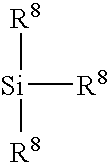Monofunctional branched polysiloxanes, compositions and processes of preparing the same
a polysiloxanes and monofunctional technology, applied in electrographic processes, instruments, transportation and packaging, etc., can solve the problems of displacement of toner, unsuitable simultaneous interaction with components other than the fuser surface, and undesirable toner contamination of the fuser surface, so as to improve the anti-adhesion properties and protect the fuser surfa
- Summary
- Abstract
- Description
- Claims
- Application Information
AI Technical Summary
Benefits of technology
Problems solved by technology
Method used
Image
Examples
example 1
Preparation of a Branched Polysiloxane by Condensation Synthesis
[0190]A three neck flask is charged with 100 grams of D4, 10 grams of DMS-T03, 85 grams of DMS-S 15, and 4.67 grams of methyl triethoxysilane. TMAH catalyst is added at a ratio of 0.001 gram / 100 grams of solution and the mixture is stirred for 1 hour under a nitrogen blanket. A 1.26 gram amount of 1,3 aminopropyldimethylethoxysilane is added to the mixture and the temperature raised to 80° C. for 16 hours. The mixture is then heated to 140° C. for about 10 minutes and cooled. A nitrogen sparge is bubbled through the mixture after heating to 170° C. for 8 hours under vacuum. The product is cooled and filtered. The mixture is determined to have a number average molecular weight of 5200 by size exclusion chromatography, a viscosity of 345 centipoise (“cp”) measured using a Brookfield viscometer which gives viscosity in terms of cp, and an amine content of 0.06 meq / gram by titration with HCl.
example 2
Preparation of a Branched Polysiloxane by Equilibration Synthesis
[0191]A branched polysiloxane (45 grams) and an amine functionally terminated polydimethyl siloxane (10 grams) (both prepared as described below) are combined in a flask with 0.1 ml of TMAH and heated to about 80° C. for 1 hour. The temperature is then raised to about 180° C. to quench the catalyst. The resulting product is predicted (by simplified well known chemical kinetics) to comprise about 25 percent branched PDMS with an average of 1.5–1.7 branch points. The branched polysiloxane is also predicted to comprise about 40 percent of the branches containing a single functional group at the end of a branch. The fluid has a viscosity of 293 cp, a number average molecular weight (excluding cyclics) of 10900 and an amine content of 0.047 meq / gram.
[0192]The branched polysiloxane is prepared by combining in a flask 1.66 grams of a mixture of methyltris(trimethylsiloxy)disiloxane (making up about 90 wt % of the mixture) and...
example 3
[0195]A branched polysiloxane and amine functionally terminated polysiloxane are combined substantially the same as Example 2, except in the preparation of the branched polysiloxane only 55 g of D4 are used instead of 100 grams, and in the preparation of the amine functionally terminated polysiloxane only 50 g of D4 are used instead of 74.5 grams. The product has a viscosity of about 140 cp and an amine content of about 0.1 meq / gram.
PUM
| Property | Measurement | Unit |
|---|---|---|
| weight average molecular weight | aaaaa | aaaaa |
| weight average molecular weight | aaaaa | aaaaa |
| molecular weight | aaaaa | aaaaa |
Abstract
Description
Claims
Application Information
 Login to View More
Login to View More - R&D
- Intellectual Property
- Life Sciences
- Materials
- Tech Scout
- Unparalleled Data Quality
- Higher Quality Content
- 60% Fewer Hallucinations
Browse by: Latest US Patents, China's latest patents, Technical Efficacy Thesaurus, Application Domain, Technology Topic, Popular Technical Reports.
© 2025 PatSnap. All rights reserved.Legal|Privacy policy|Modern Slavery Act Transparency Statement|Sitemap|About US| Contact US: help@patsnap.com



